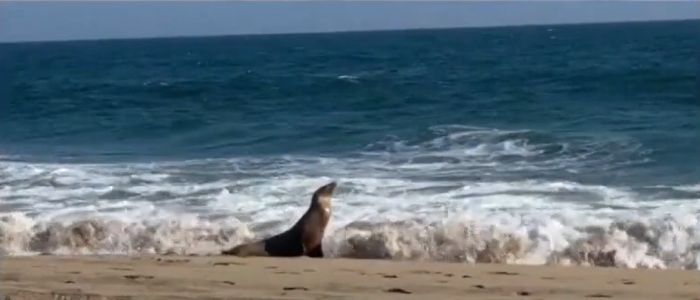 The BBC reports that last month a surfer paddling off the coast of Southern California was attacked by a sea lion that lunged at him, bit him, and dragged him off his board. “It looked possessed,” the surfer, Rj LaMendola wrote in a Facebook post, saying the animal involved in the encounter was “feral, almost demonic”.
The BBC reports that last month a surfer paddling off the coast of Southern California was attacked by a sea lion that lunged at him, bit him, and dragged him off his board. “It looked possessed,” the surfer, Rj LaMendola wrote in a Facebook post, saying the animal involved in the encounter was “feral, almost demonic”.
It turns out that the sea lion was not “demonic” but “domoic.” The sea mammal was poisoned by ingesting domoic acid — a neurotoxin produced by a toxic algal bloom. In the ecosystem, sea lions were perhaps hit the worst, suffering from seizures, brain damage, dehydration, and muscle spasms as hundreds began to die.
How was the sea lion poisoned? Small fish, such as anchovies and plankton, probably ate toxic algae that was blooming in the Pacific Ocean. Larger mammals, including sea lions and dolphins, then ate the fish and the toxic algae they carried, researchers found.
John Warner, CEO of the Marine Mammal Care Center in Los Angeles – which is treating sea life sickened by the bloom – told the BBC these animals aren’t “naturally aggressive or actually attack people” but the toxins impact their behavior. The wildlife hospital in Los Angeles has responded to more than 190 animals in distress between Feb. 20 and March 28.
“These animals are reacting to the fact that they are sick,” he explained. “They’re disoriented, and most likely, most of them are having seizures, and so their senses are not all fully functional as they normally would and they’re acting out of fear.”
“It’s really hard. It’s emotionally taxing,” Dave Bader, a marine biologist at the Marine Mammal Care Center, told the Washington Post.
With no known antidote, rehabilitation centers focus on making sure the seals and sea lions get the food, fluid, and anti-seizure medicine needed for recovery. Roughly half survive, Bader said. In the case of many beached dolphins, the best they can do is humanely euthanize them.
This particular algae bloom has appeared four years in a row across California, raising concerns it might be turning into an annual event. The bloom of algae started earlier than normal this year and has spread roughly 370 miles of the iconic Southern California coastline.
What supercharged this year’s outbreak is still a mystery. Is it runoff from farms, ash from the recent wildfires or climate change that is fueling the algal growth that is leading to the poisonings? Scientists are investigating.
“The ocean is telling us something. Things aren’t right,” Bader said. “If we don’t do something about it, then this is the future we’re going to be looking at.”
Dead, sick sea lions and dolphins washing ashore SoCal beaches: What we know
Thanks to Alaric Bond for contributing to this post.
